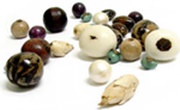Botany Related Pages:
- Botany
- Taxonomy
- Cell Fractionation
- Tracer Techniques
- Herbarium
- Plant Kingdom Classification
- Virus
- Structure of Virus
- Viral Infection
- Viral Replication
- Bacteria
- Classification of Bacteria
- Bacterial Cell Structure
- Reproduction of Bacteria
- Helpful Bacteria
- Others Helpful Bacteria
- Fungi
- Classification of Fungi
- Uses of Fungi
- Algae
- Red Algae
- Brown Algae
- Green Algae
- Economic Importance of Algae
- Lichens
- Moss Plant
- Non flowering Plants
- Plant Growth
- Plant Growth Regulators
- Macronutrients for Plants
- Micronutrients in plants
- Plant Movement
- Plant Tissue
- Simple tissue
- Vascular Tissue
- Vascular Bundle
- Tree roots
- Root Function
- Plant stem
- Nature of plant stem
- Function of Stem
- Stem Modifications
- Aerial Stem Modifications
- Sub Aerial Stem Modification
- Tree Leaves
- Anatomy of Leaf
- Chloroplast
- Chlorophyll
- Plant Fertilization
- Pollination
- Cross-pollination
- Plant Breeding
- Plant water relation
- Ascent of Sap
- Transpiration
- Affecting Factors of Transpiration
- Types of Fruits
- Seed Structure
- Seed Germination
- Types of germination
- Dispersal of Seeds
- Types of Flowers
- Flower Parts
- Floral Diagram
- Calyx
- Corolla
- Inflorescence
- Minerals Nutrition
- Auxin
What is seed?
Before going to discuss about the seed structure let us get some idea about the seed. The seed develops from the ovule after fertilization. It contains the embryo that develops from the 2n zygote, which remains in dormant stage for a considerable time period and finally germinates to produce the seedling. The embryo consists of an axis, which includes the radicle, plumule and the cotyledons. There are two cotyledons present in dicot seeds and a single cotyledon present in monocot seed. The embryo derives its nourishment from the endosperm, the dicotyledonous seeds are endospermic or albuminous except arum. The seed structure shows that the seed is protected by a two layered seed coat viz., testa and tegme. The seed bearing plants are called spermatophytes, which include the gymnosperms and angiosperms. The gymnosperms are naked seeded plant, while the seeds in angiosperms are covered. So as the definition of the seed it may say that the angiospermic seed is the structure developing from fertilized ovule, which remain contained within the fruit.
General Seed Structure
A typical seed consists of the seed coat and the kernel within, and different components are as follows:
Seed coat
The seed coat is composed of two distinct layers, viz., the outer testa and the inner tegmen. Usually the testa is thick and the tegmen is thinner in outline and the testa and tegmen are easily separable from each other as per seed structure. But in the dry indehiscent fruit of caryopsis, (wheat, paddy, maize etc.), the testa and tegmen are tightly fused to each other (inseparable). In seeds like paddy and castor, a thin, dry membrane is located in between the seed coat and kernel, which is called perisperm and it, is in fact the leftover of nucellus.
Kernel
The entire inner content of the seed surrounded by the seed coat is called kernel. It may be formed only of embryo as in pea and gram or may contain both embryos and endosperm, e.g. castor, paddy, wheat etc.
The seed where endosperm is present, is called endospermous or albuminous and the seed where endosperm is absent, is called exalbuminous or non-endospermous. The various components of kernel are as follows on the basis of seed structure:
Embryo
The embryo develops from the diploid zygote; it consists of:
i) embryonal axis or tigellum
ii) cotyledons.
Tigellum
It is the minute, stem-like portion of seed structure. The point of attachment of the cotyledons to the tigellum is called the nodal zone. The portion of tigellum above this zone is called the epicotyl, while the part of the axis below this zone is called hypocotyl. The growing tip of the epicotyl is called plumule, while that of the hypocotyl is called radicle. In case of monocot seeds, the plumule and radicle are covered by protective sheaths called coleoptile and coleorhiza respectively.
Cotyledons
The seed leaves are called cotyledons. There is a single terminal cotyledon in monocotyledonous seed structure, e.g. maize and two lateral cotyledons in dicotyledonous seeds, e.g. gram. Sometimes there may be more than two cotyledons present in polycotyledonous seeds, e.g. Pinus.
In exalbuminous seed, the stored food is present within the cotyledons and they become thick and fleshy, but in albuminous seed (paddy), the food is stored in the endosperm, outside the cotyledon, so the cotyledons become thin.
Endosperm
In angiosperms, the endosperm is triploid formed due to the fusion of the diploid, fusion nucleus and the male gamete. It is the source of food for the embryo; it is highly reduced in dicotyledonous seed except castor, while it is voluminous in monocotyledonous seed structure except arum. The quantity of stored food within the endosperm or in the cotyledon determines the dormancy period of the seed.
So, those above were briefly all about the seed structure . On the basis of the presence or absence of endosperm and the number of cotyledons, seeds may be classified into four major types, those are:
i) Dicotyledonous exalbuminous seeds : The seed contains two cotyledons close to the embryo axis and they are devoid of endosperm, e.g. pea, gram etc.
ii) Dicotyledonous albuminous seeds : These seeds contain two cotyledons in their embryo but profuse endosperm present, e.g. castor, gourd etc.
iii) Monocotyledonous exalbuminous seeds : These seeds contain one cotyledorv at the end part of the embryo axis, but are devoid of endosperm, e.g. arum, Alisma etc.
iv) Monocotyledonous exalbuminous seeds : These type seed structure contain one cotyledon in their embryo but huge endosperm present, e.g. paddy, maize etc.


